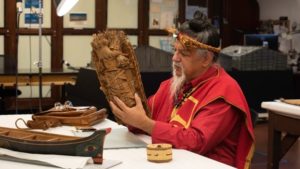On the busy corner of Lafayette and Dunklin streets in Jefferson City, there are unraked lawns, a parking lot and a tennis court. But it used to be a booming Black commercial area with hotels, stores and restaurants,
70-year-old Glover Brown used to live there and has fond memories of the neighborhood.
“It was a home. It was a workplace. It was entertainment. And when I say that, it was for the Black community. And during segregation, this was where they were relegated to,” he said. “It was totally self contained. It had its own grocery stores, even had a multi-story hotel, shops, churches. And so we got to see a lot of things that growing up, we took for granted.”
Many of those places were included in the Green Book, which listed safe places for Black customers.
Michelle Brooks, a local history author and former journalist, featured the area known as The Foot District — at the ‘foot’ of the city’s historically Black college, Lincoln University— in Lost Jefferson City, a book about the history of Missouri’s capital city. Her research included oral histories from the Brown brothers.
“I don’t feel like it’s over, there’s not a finality to it…The Foot really deserves its own book devoted to it,” she said.

Currently, about 19 percent of Jefferson City’s population is Black or African American. Due to urban renewal efforts in the -50s and -60s, the Brown’s family was forced out of the area. “Decaying” areas were reconstructed and gentrified. Many of those labeled neighborhoods were communities of color. Hundreds of families were displaced. Their successful barbecue restaurant eventually closed down.
“It came through Jefferson City like a storm coming over the horizon. Everybody was buzzing and talking about something was coming, and we didn’t know what it was. And then all of a sudden, one day, we were told we were moving,” Brown remembered.
The wealth and safety net the nine-member Brown family had built was gone. Brown said they then moved to a rural area with intense racism–including an explosive being thrown at their house.
“This was the kind of situation that you saw on television or in movies, but we actually lived it. And so like I said, as I grew older, I wanted to see that abolished. And so if it took me getting directly involved in a non-adversarial way, I wanted to make a change,” Brown said.

Brown traced his family history back to when they were first brought to Missouri, before statehood, as slaves in what is now southwest Missouri.
And now, decades later, Glover and his brother Arthur are making sure this history–their history–won’t be forgotten. Along with other work around the city to make sure Black lives are remembered, they worked with the city, the mayor and the John Hope Franklin Center for Reconciliation to right past wrongs.
I thought to myself: without my intervention, that the memory of that area over time was going to be lost to the ages.
Glover Brown
They recently got the Foot District specially designated by the city as an Official Historic Legacy District. Glover said it didn’t fit the Department of Interior and the National Parks Services’ definition of an historic district.
And the city commissioned a plaque on the district’s border. This came after years of obstacles, challenges and misunderstandings. Glover Brown said he wanted to have a historic district, but the city wasn’t yet prepared for creating a historic district other than a proclamation. It wasn’t until eight years after the initial question of having a historic district when Glover—on a commission to review and revise historic codes for the city—found out Lafayette street didn’t have a historic designation.
Now that it is recognized, the brothers want their efforts to be used as a template for other communities hoping to ensure small town Black history is memorialized.
“Hopefully my kids and grandkids and great grandkids will one day see that area back somewhat like we used to,” Arthur Brown said. The brothers are still working on promoting economic development in the area and community development.
Defining reparations
Glover said when a municipality recognizes an injustice and attempts to correct a past wrong, that’s reparations. Although he commended the city, he said what’s happening in Jefferson City and the Foot District right now might not fit a definition of reparations.
According to the definition from the United Nations, five conditions need to be met for an action to be considered as reparations: restitution, compensation, rehabilitation, satisfaction and guarantees of non-repetition. But, many of these requirements can be relative according to what the past wrong is and how the people wronged feel after an attempted reparatory action.
“Reparations can mean a couple of different things. Jokingly, we’re still waiting on our 40 acres and a mule,” he said as he laughed.
And Glover’s thoughts about what reparations means, is a microcosm of the same larger conversation around the country.
In Missouri’s urban centers, activists are more interested in financial reparations. St. Louis has been working toward them on a city-wide level with involvement and support from its first Black female mayor Tishaura Jones. Jefferson City has never had a Black mayor. Jones signed an executive order creating a commission to “explore and recommend opportunities for reparations.”
Kansas City also very recently assigned a committee to study reparations.
“I think the term [reparations] is, you know, partly avoided now, because it’s not clear what it means to many people. And it means different things to different people. We’re going to see, pretty soon I think, a lot of kind of grappling with that question of the meaning of reparations,” Geoff Ward said. He is a professor of African and African American Studies and the director of the WashU & Slavery Project at Washington University in St. Louis.
He added the conversation around reparations “should include consideration of transformative transitional justice. We should pursue measures with the potential to truly transform our society, dismantling structural racism, ensuring the lasting impact of repair.”
“I’m not, I guess, personally that invested in the term reparations, as much as I am invested in the recognition that there is harm that has to be addressed,” he said. “And ideally addressed in a way that is transformative, rather than, you know, sort of more limited.”
And experts said a vital first step in achieving transformative reparations is for a state to formally apologize for its involvement in slavery. Of the eighteen slave states, Missouri is one of nine that has not apologized.
Daive Dunkley, an Associate Professor in the Department of Black Studies and Adjunct Professor in the Department of History at the University of Missouri said an apology for slavery is integral in acknowledging discriminatory practices that still occur in present day.
“One of the things that I want people to understand is that even though slavery was officially abolished—when legal slavery was officially abolished in this country in 1865, it has had an afterlife. Many afterlives, actually,” Dunkley said.
Dunkley wrote the foreword for A Fire Bell in the Past: The Missouri Crisis at 200, Volume II. “There seems no better time than the Missouri bicentennial for the state to finally start a serious reckoning with its founding in slavery,” he wrote. “The beginning of Missouri’s third century as a state presents an opportunity for the state to make a formal apology for slavery and use legislation and monetary resources to commit itself to fighting racism so that all Missourians can flourish regardless of their race.”
Urban, rural solutions
Ward said people in St. Louis and Kansas City, where both mayors are Black, may feel more comfortable pushing for financial reparations partially because of that political representation from people who look like them.

Dr. Ayanna Shivers is a test of that question in a rural area. She became Mexico, Missouri’s first Black female mayor in 2019. About five percent of Mexico’s population is Black or African American. Shivers, the oldest of three girls, ended her term and is currently on the Mexico City Council and a pastor. She said sometimes, she thinks people may have a “different” idea of what she thinks reparations should or shouldn’t be.
“It’s about the power. And for true reparations to take place, there would have to be an exchange,” she said. “And so my mindset is, don’t ask somebody to give up their power, because that’s like, you know, you asking a person when they’re in the playoffs to give up their playbook to the opposing team.”
Shivers said from her standpoint, reparations is born out of networking and sharing social capital. So she and other Black community leaders started making their own changes, gained community support and increase access to power. There are free tutoring programs to level the playing field, nonprofits that provide networking and support opportunities, and even a city sustainability project to ensure people continue thriving after that. All of these programs have garnered support from the town of more than 11,000.
Shivers told the story of how Mexico-native and Los Angeles Clippers head coach Tyronn Lue introduced a small form of reparations in the form of Fourth of July celebration access. On an annual basis, Lue started a professional fireworks display in Garfield Park, since the other fireworks display wasn’t accessible to everyone within his community. The park was eventually renamed Tyronn Lue Park.
Shivers said small town efforts like these are reparations–and can be just as impactful as those in big cities.
“Some of it is understanding, we deserve the 40 acres and a mule. And that, to access it, we may not be able to wait on someone to hand it to us,” she said. “We’ll just have to acquire the skill set to do it ourselves—and that’s okay.”
For the audio transcript, click here.




